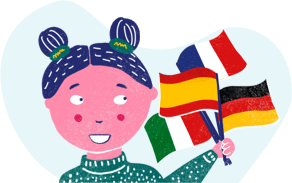Gratitude is a universal language that transcends borders and cultures. Instilling a sense of appreciation and acknowledgment in children is a valuable lesson that extends beyond mere manners; it fosters empathy, respect, and a deeper understanding of diverse cultures.
Teaching children how to say “thank you” in different languages not only broadens their linguistic horizons but also promotes a sense of global citizenship and appreciation for diversity.
The Art of Gratitude in Multiple Languages
French: “Merci”
In the enchanting language of French, expressing gratitude is as graceful as the language itself. “Merci” (pronounced mehr-see) is the word children can learn to express their thanks. Teaching them subtle pronunciation and inflection adds a touch of elegance to their expressions of appreciation.
Spanish: “Gracias”
The warmth and vibrancy of the Spanish language are encapsulated in the word “Gracias” (pronounced grah-see-us). Encouraging children to roll the ‘r’ playfully and articulate the sounds with enthusiasm infuses their gratitude with the joyful spirit of Spanish culture.
Italian: “Grazie”
Italian, known for its melodious rhythm, offers “Grazie” (pronounced grah-tzee-eh) as the expression of gratitude. Helping children master the musical intonation of this word adds a touch of Italian charm to their expressions of thanks.
German: “Danke”
The German language, known for its precision and structure, employs “Danke” (pronounced dahn-kuh) as the word for expressing gratitude. Encouraging children to enunciate each syllable crisply and clearly imparts a sense of gratitude with the precision that the German language embodies.
Cultural Enrichment and Global Awareness
Teaching children how to say “thank you” in different languages serves a dual purpose. Firstly, it exposes them to the diverse sounds and rhythms of languages, broadening their understanding of linguistic diversity.
Secondly, it instills respect for cultural differences and fosters an inclusive mindset, encouraging them to appreciate and respect various ways of expressing gratitude around the world.
Fun and Engaging Learning Methods
Making the learning process enjoyable is essential in engaging children. Using games, flashcards, songs, or interactive activities in which they practice saying “thank you” in various languages can transform the learning experience into a fun and memorable adventure.
You could even visit a local authentic restaurant to try out that country’s cuisine and have your child say “thank you” to the staff.
Parental Involvement and Role Modeling
Parents and guardians play a crucial role in modeling gratitude and appreciation. Incorporating these phrases in daily conversations and expressing thanks in multiple languages helps children understand the significance of being thankful in diverse settings.
Benefits Beyond Words
Teaching children to say “thank you” in different languages goes beyond the linguistic aspect. It nurtures open-mindedness, empathy, and a deeper understanding of diverse cultures. Children become more equipped to navigate a globally connected world with a sense of respect and appreciation for all cultures.
Conclusion
In an increasingly interconnected world, the ability to appreciate and understand diverse cultures is an invaluable skill. Teaching children how to say “thank you” in multiple languages not only equips them with linguistic knowledge but also fosters a mindset of gratitude, respect, and global awareness.
As they learn to express thanks in French, Spanish, Italian, and German, they embark on a journey that transcends mere words, embracing a world of cultural richness and understanding.
Incorporating these phrases into their vocabulary plants seeds of appreciation and empathy, nurturing a generation that values and respects the diversity that makes our world so beautifully rich.



Choose a language
One Third Stories courses are available in French, Spanish, Italian and German.
Select a subscription
Choose between monthly or annual payment options.
Start learning
Receive your first audiobook and Story Box, and let the learning begin!.

Choose a language
Our courses are available in French, Spanish, Italian and German.

Select a subscription
Choose between monthly or annual payment options.

Start learning
Receive your first audiobook and Story Box, and let the learning begin!.
